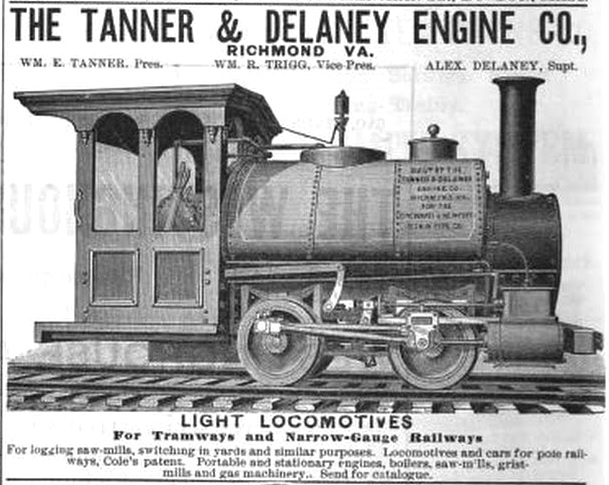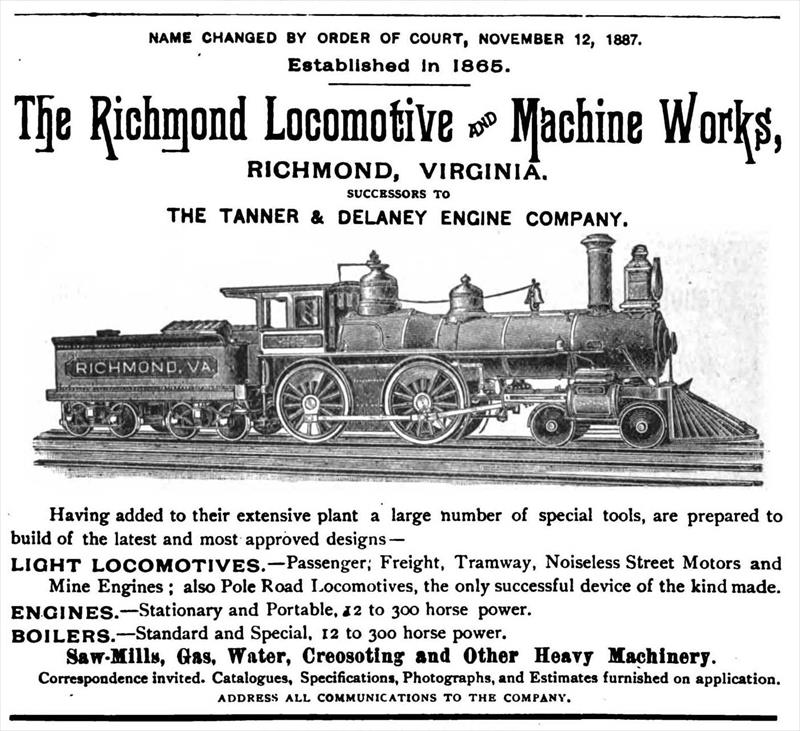Metropolitan Iron Works, also known as Metropolitan Iron and Brass Works (or Metropolitan Brass and Iron Works), and its operators and successors manufactured machinery and locomotives from 1865 through 1901. The primary principals for the first two decades were William E. Tanner, Jacob Otto Ehebts, and Alexander Delaney. Delaney had been superintendent of Tredegar Iron Works, and Tanner and his father had also been associated with Tredegar. According an 1870 retrospective in the Richmond Dispatch, the iron works was operated by partners Tanner & Ehbets, changed Jan. 1, 1868 to Tanner, Ehbets & Delaney, and with Ehbet's retirement on July 31, 1869, it became William E. Tanner & Co., with Delaney still active in management. The latter name was used through 1881, according to Richmond city directories. In the 1882 directory, the firm was renamed Tanner & Delaney Engine Co. The business began in a small bulding at the southeast corner of S. 7th St. and Canal St. It expanded west on Canal St. to S. 6th, and back to E. Cary St. It included the Pae mansion on S. 6th which was used for pattern storage. The works was largely destroyed by fire Nov. 11, 1881, and rebuilt on a new 7-acre site in upper Shockoe Valley, outside the city limits. Products during these decades included portable and stationary steam engines, locomotives, sawmills, boilers, grist mills, gas works, and a spark arrester invented by Delaney (US Patent 209,668).

Dec. 31, 1886 advertisement
In 1887, William E. Tanner and Alexander Delaney left the business, and the name changed to Richmond Locomotive & Machine Works. The manufacture of sawmills continued for a few years, but the business continued to manufacture stationary steam engines and a variety of boilers. In 1901, the company merged with 7 other companies to form American Locomotive Co. American continued to manufacture locomotives until 1927 at the Shockoe Valley plant. Around 1902, American sold its Tanner & Delaney Engine Co. patterns to Richmond Iron Works, which continued to make replacement parts until its 1912 bankruptcy. In 1917, American bought the Richmond Iron Works plant on N. Boulevard for additional foundry capacity.

1888 advertisement
Although the first source below said that Tanner and Delaney were forced from the business, a contemporary newspaper account said that Delaney retired to go into business for himself and was given a gold watch and framed testimonial at a convivial reception May 14, 1887. On June 1, 1887, he joined Tappey & Steel of Petersburg, VA. Tanner resigned effective Jan. 1, 1887, and was appointed special agent for the company in March, 1887. He was then solicited by Minnesota investors who were building a large rail car factory in Duluth, MI, but the venture failed within a few years.
The Pae mansion mentioned above was the former home of James Valence Pae (1793-1865), a partner in Sampson & Pae's Richmond Foundry, located nearby at S. 5th and Byrd Streets. Pae's foundry was completely destroyed in the Evacuation Fire and not rebuilt. Pae built mill machinery, water wheels, and engines.
Information Sources
- A National Register of Historic Places application provided information on this business, including its predecessor and successor firms. "The firm began in 1865 in a machine shop owned by William E. Tanner, who was joined by Alexander Delaney from Tredegar. The resulting firm was called Metropolitan Iron Works, and in 1865 they began to manufacture steam boilers, stationary engines, and saw mills. At about the same time, Tanner and another Richmond businessman, Jacob Ehbets, founded a used locomotive purchasing and reconditioning business; this was a short-lived enterprise, but one which was to later bear fruit. The first listing for the operation in a Richmond city directory was in 1871, at 7th and Canal streets." In 1887 Tanner and Delaney were forced out and the name changed to Richmond Locomotive & Machine Works. Sawmills were still part of the product line. By 1900 they were making a variety of locomotives and the company name was shortened to Richmond Locomotive Works. By that time they had 5,000 employees. The following year the company merged with several smaller makers to form the American Locomotive Co. Although it is clear that sawmills were a sideline, at best, by 1887, it is not clear when their manufacture ceased. The National Register application was for a site at N. Boulevard and Leigh St., but is incorrect in several respects. See Richmond Iron Works article for corrections.
- The July 1877 issue of Scribners Monthly has an article on the rebuilding of Richmond following the civil war, including this snippet: "The Metropolitan Iron and Brass Works on Cary street, reaching from Seventh to Sixth, soon became a powerful auxiliary in the work of reparation..."
- Advertisements in Haddock's Wilmington, N.C., Directory, and General Advertiser, 1871, available online at the UNC web site. The two full-page ads are nearly identical.
Metropolitan Iron and Brass Works,
Canal from 6th to 7th Sts., Richmond, Va.,
WM E. TANNER & CO.
Manufacturers of
Stationary and Portable
ENGINES and BOILERS
Saw, Grist, Plaster and Bark Mills,
Casting of Brass and Iron,
Forgings, Bridge Iron, Freight Cars, &c.,
Repairs of all kinds promptly done, and new machinery of
every description designed and built. Agents in the South-
ern States for
BLAKE'S PATENT STONE BRAKE,
an invaluable instrument for those having any kind of stone
to break into fragments.
Send for circular.
W. E. Tanner Alex. Delaney
- The 1873 Wiley's American iron trade manual of the leading iron industries of the United States lists Metropolitan Iron and Brass Foundry of Richmond, Va.: "Steam engines, portable and stationary, sawmills, etc."
- Richmond city directories
- Richmond Dispatch, May 15, 1887, Pg. 8.
- The Wikipedia page Richmond Locomotive Works provides additional history.
- Find A Grave memorial for Col. William Elam Tanner
- Beers Illustrated Atlas of the City of Richmond, Va., 1876
- Pae family genealogy page